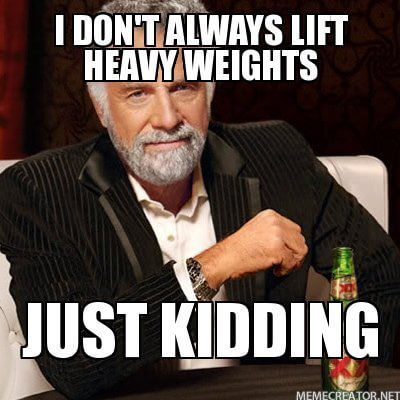There are a lot of popular novice strength training programs. Though people like to obsess about the differences between them, they’re all basically set up the same way (example one, two, three, four).
All of them accomplish their intended purpose relatively well: getting you somewhat proficient with the core barbell lifts. However, they all have two major pitfalls that can be easily remedied to a) make them more effective and b) set you up for greater success when you move on to another training program.
1. Periodize
Periodization is a massive subject, and it’s easy to get overwhelmed by the minutia. However, in the simplest terms, periodization simply means “having defined times in your training where you emphasize different goals.” The application can get really hairy, but the easiest way to periodize your training without an in-depth knowledge of the theory behind it – changing set and rep schemes.
Yep, it can be that simple, especially for strength training. For most other sports, sequencing strength development, conditioning aspects (both general and sport-specific), and saving enough energy for skill practice can make periodization a complicated chore. For strength training, however, it’s pretty straightforward: include enough variation that training doesn’t become stale (both psychologically, and physiologically. Doing the exact same stuff all the time gets boring, and as your body becomes more adapted to one particular stimulus, it stops responding quite as robustly to it), but keep the parameters narrow enough that you’re not trying to make your body adapt in a dozen different ways at the same time.
So, should you periodize your training? In a word: “YES!”
A 2004 meta-analysis essentially showed that periodized training is almost always better than non-periodized training. To quote the authors, “As a result of this statistical review of the literature, it is concluded that periodized training is more effective than non-periodized training for men and women, individuals of varying training backgrounds, and for all age groups.” That’s about the most conclusive statement you’ll hear from a scientist.
Here’s the easiest way to periodize one of the common beginner training programs: instead of sticking with the kosher 3-5 sets of 5 reps for everything, proceed thusly:
Start with 3×8 for your lifts, adding weight each session until you’re unable to do so. Once you can’t add weight every session anymore…
Switch to 5×5. Repeat the process.
Then 5×3.
You don’t have to switch all your lifts over to the new rep scheme all at once. If you plateau on your bench or overhead press before your squat or deadlift, go ahead to switch the stalled lift to the new rep scheme, and continue as you were with the others.
This setup allows you to stick with the basic progressive overload you would usually get from a beginner’s program, while also implementing some basic periodization, which will almost certainly make the program more effective for you. You’ll be able to linearly add weight for a longer period of time, and odds are very good that you’ll end up with bigger maxes than if you stuck with 3-5×5 for the entire program.
Alternately, you can vary rep schemes within the training week itself. For example, instead of doing sets of 5 for squats three times per week, you could do sets of 8 on the first day, sets of 5 on the second day, and sets of 3 on the third day, adding weight each week This approach is similar to the daily undulating periodization setup in the study I wrote about in this article, which produced dramatically better strength gains than a routine that kept the sets and reps constant for a prolonged period of time.
2. When you finally plateau, add volume
Something I’ve never understood is the stock advice of “when you stall with your linear gains, take 10% off the bar, and build back up using the same progression.”
What’s supposed to happen in the couple of weeks while you build back to your old plateau? Is that when the gains fairy visits to defy the basic principle of progressive overload, thereby granting you a substantially improved response to the exact same stimulus? Yes, I know the reason given is that it’s supposed to help alleviate short-term fatigue so that you can progress to heavier weights when you’re a bit fresher, but that’s not a long-term solution.

Instead, if you decide to stick with the same program, deload a little more than you otherwise would, and build back up with one extra set per exercise. So if you were doing 3 sets, do 4 sets. If you were doing 5 sets, do 6 sets. The scientific literature agrees almost unanimously that more volume is better for both strength and hypertrophy.
If you want to combine these two pieces of advice, deload to about 10-15% below where you switched from 3×8 to 5×5. Build back up by proceeding from 4×8 to 6×5 to 6×3. This will more reliably keep your progress going than sticking with 3-5×5, deloading a bit, and building back up with the same sets and reps. You can do the same thing if you’re varying your rep schemes during each training week as well. If you plateau on the day you’re doing sets of 8 before you plateau on the day you’re doing sets of 5 or 3, just decrease the weights by about 15% of your 8s day, add a set for the exercise(s) that have stalled, and start adding weight again.
This will also help you circumvent a typical problem people run into when they move on to another program once they’re done with the novice phase of their training. Many people find themselves unable to handle the training volume necessary to continue making progress, because low-volume novice programs make them stronger without sufficiently increasing their work capacity, which is the cornerstone of long-term strength development. They end up having to take one step back (building their work capacity) in order to take another step forward (actually getting stronger). If you DO find yourself in that situation, I’ve written about how you can start moving forward again here.
If you’re curious about what you should do next, check out this article, which gives a comprehensive overview of the entire training process from the first day you pick up a bar, until you reach your ultimate potential.
I’m sure if you’re a regular Strengtheory reader, none of this is new to you, BUT it will be new and helpful to a lot of novice lifters. Share it around so they can see better results in their first few months under the bar, and perhaps get their first exposure to the practical application of periodization.




